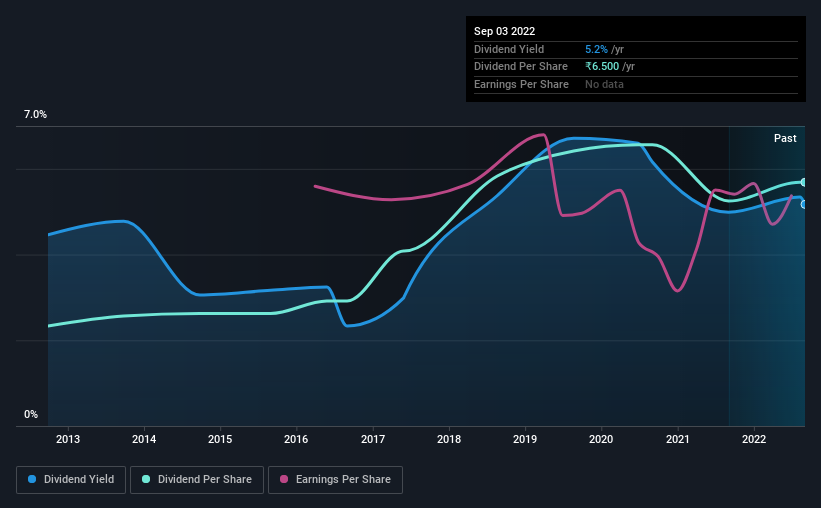
Balmer Lawrie & Co. Ltd. (NSE:BALMLAWRIE) has announced that it will be increasing its dividend from last year's comparable payment on the 27th of October to ₹6.50. This will take the annual payment to 5.2% of the stock price, which is above what most companies in the industry pay.
View our latest analysis for Balmer Lawrie
Balmer Lawrie's Payment Has Solid Earnings Coverage
While it is great to have a strong dividend yield, we should also consider whether the payment is sustainable. Prior to this announcement, Balmer Lawrie's dividend was making up a very large proportion of earnings, and the company was also not generating any cash flow to offset this. This is a pretty unsustainable practice, and could be risky if continued for the long term.
Earnings per share could rise by 0.3% over the next year if things go the same way as they have for the last few years. If the dividend continues along recent trends, we estimate the payout ratio could reach 76%, which is on the higher side, but certainly still feasible.

Dividend Volatility
Although the company has a long dividend history, it has been cut at least once in the last 10 years. Since 2012, the annual payment back then was ₹2.67, compared to the most recent full-year payment of ₹6.50. This works out to be a compound annual growth rate (CAGR) of approximately 9.3% a year over that time. It's good to see the dividend growing at a decent rate, but the dividend has been cut at least once in the past. Balmer Lawrie might have put its house in order since then, but we remain cautious.
Dividend Growth May Be Hard To Achieve
With a relatively unstable dividend, it's even more important to see if earnings per share is growing. However, Balmer Lawrie's EPS was effectively flat over the past five years, which could stop the company from paying more every year. Slow growth and a high payout ratio could mean that Balmer Lawrie has maxed out the amount that it has been able to pay to shareholders. That's fine as far as it goes, but we're less enthusiastic as this often signals that the dividend is likely to grow slower in the future.
In Summary
Overall, we always like to see the dividend being raised, but we don't think Balmer Lawrie will make a great income stock. While Balmer Lawrie is earning enough to cover the payments, the cash flows are lacking. We would probably look elsewhere for an income investment.
It's important to note that companies having a consistent dividend policy will generate greater investor confidence than those having an erratic one. Still, investors need to consider a host of other factors, apart from dividend payments, when analysing a company. For example, we've identified 2 warning signs for Balmer Lawrie (1 is significant!) that you should be aware of before investing. Looking for more high-yielding dividend ideas? Try our collection of strong dividend payers.
Valuation is complex, but we're here to simplify it.
Discover if Balmer Lawrie might be undervalued or overvalued with our detailed analysis, featuring fair value estimates, potential risks, dividends, insider trades, and its financial condition.
Access Free AnalysisHave feedback on this article? Concerned about the content? Get in touch with us directly. Alternatively, email editorial-team (at) simplywallst.com.
This article by Simply Wall St is general in nature. We provide commentary based on historical data and analyst forecasts only using an unbiased methodology and our articles are not intended to be financial advice. It does not constitute a recommendation to buy or sell any stock, and does not take account of your objectives, or your financial situation. We aim to bring you long-term focused analysis driven by fundamental data. Note that our analysis may not factor in the latest price-sensitive company announcements or qualitative material. Simply Wall St has no position in any stocks mentioned.
About NSEI:BALMLAWRIE
Balmer Lawrie
Engages in industrial packaging, greases and lubricants, chemicals, logistic services and infrastructure, refinery and oil field, and travel and vacation services businesses in India and internationally.
Flawless balance sheet average dividend payer.
Similar Companies
Market Insights
Community Narratives




